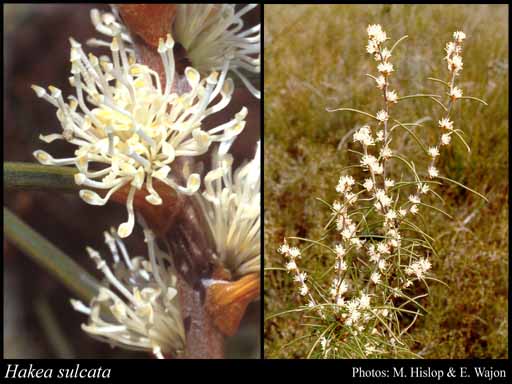- Reference
- Trans.Linn.Soc.London 10:180 (1810)
- Conservation Code
- Not threatened
- Naturalised Status
- Native to Western Australia
- Name Status
- Current
Erect, non-lignotuberous shrub, 0.4-2 m high. Fl. white-cream, Aug to Nov. Sandy soils over laterite, clay.

Scientific Description
Shrubs, 1-2 m high; branchlets hairy. Leaves alternate, 20-185 mm long, 1-2 mm wide, glabrous; lamina terete, entire. Inflorescences axillary, white; pedicels 1-2 mm long. Perianth 6-7 mm long, glabrous; ovary glabrous; pistil 5-9.5 mm long, pollen presenter conical, style glabrous. Follicles 6-8 mm long, 0.3-3 mm wide, corky tetrahedral projections (on external surfaces of fruit) absent; seed 4.8-5.5 mm long (including wing), 1-2 mm wide, the wing continuous. Flowers in August, September, October or November. Occurs in the South-west (SW) Botanical Province(s), in the Swan Coastal Plain (SWA), Avon Wheatbelt (AW), Jarrah Forest (JF), Warren (WAR) or Esperance Plains (ESP) IBRA subregion(s).
Distribution
- IBRA Regions
- Avon Wheatbelt, Esperance Plains, Jarrah Forest, Swan Coastal Plain, Warren.
- IBRA Subregions
- Dandaragan Plateau, Fitzgerald, Katanning, Northern Jarrah Forest, Perth, Recherche, Southern Jarrah Forest, Warren.
- IMCRA Regions
- Leeuwin-Naturaliste, WA South Coast.
- Local Government Areas (LGAs)
- Albany, Armadale, Augusta Margaret River, Belmont, Beverley, Boyup Brook, Busselton, Canning, Capel, Collie, Cranbrook, Dardanup, Denmark, Esperance, Gingin, Gnowangerup, Gosnells, Harvey, Jerramungup, Kalamunda, Manjimup, Murray, Nannup, Plantagenet, Ravensthorpe, Serpentine-Jarrahdale, Swan, Victoria Plains, Waroona, West Arthur, Woodanilling.